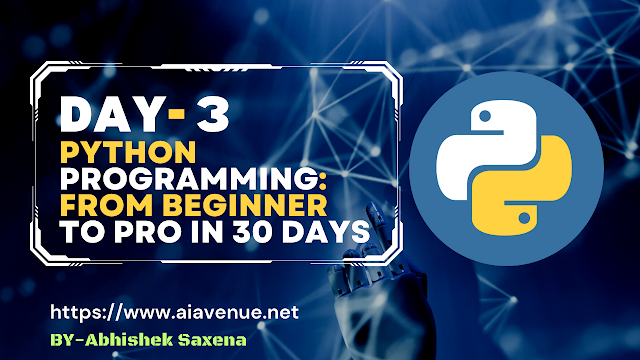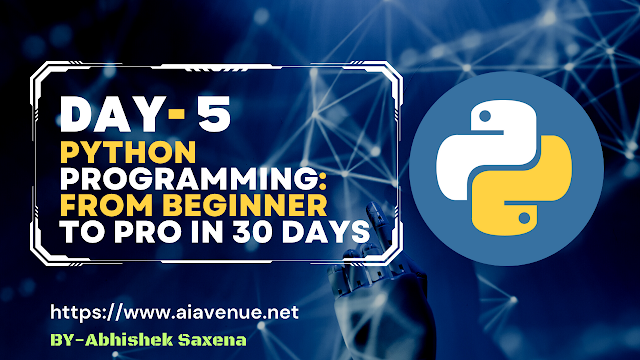 |
| Python Programming Day 3 |
Day 3: Operators and Expressions
Introduction:
In programming, operators are symbols or keywords that are used to perform various operations on values or variables. In this article, we will cover some of the commonly used operators in programming, including arithmetic operators, comparison operators, logical operators, and assignment operators. We will also discuss expressions and how they are evaluated.
Table of Contents:
- Arithmetic operators
- Comparison operators
- Logical operators
- Assignment operators
- Expressions and their evaluation
Arithmetic Operators:
Arithmetic operators are used to perform mathematical operations on numerical values. The most common arithmetic operators are addition (+), subtraction (-), multiplication (*), division (/), and modulo (%). These operators follow the standard order of operations (PEMDAS), which means that expressions are evaluated in the following order: parentheses, exponents, multiplication and division (from left to right), and addition and subtraction (from left to right).
Examples:
“Learn How to Control Program Flow in Python – Day 4” – Read more here: https://www.aiavenue.net/2023/04/day-4python-programming-from-beginner.html
Comparison Operators:
Comparison operators are used to compare two values or variables. The result of a comparison operator is a Boolean value (True or False). The most common comparison operators are greater than (>), less than (<), greater than or equal to (>=), less than or equal to (<=), equal to (==), and not equal to (!=).
Examples:
Logical Operators:
Logical operators are used to combine Boolean values and return a Boolean result. The most common logical operators are and, or, and not. The and operator returns True if both operands are True, the or operator returns True if at least one operand is True, and the not operator returns the opposite of the operand’s value.
Examples:
Assignment Operators:
Assignment operators are used to assign values to variables. The most common assignment operator is the equal sign (=), but there are also compound assignment operators that combine an arithmetic operator with an assignment operator, such as +=, -=, *=, /=, and %=.
Examples:
Expressions and their Evaluation:
An expression is a combination of values, variables, and operators that are evaluated to produce a result. Expressions can be simple or complex and can include multiple operators and parentheses. When an expression is evaluated, the operators are applied to the values in a specific order based on the order of operations.
Examples:
Expressions can also include variables, functions, and constants. When evaluating an expression, the values of the variables are substituted, and the functions are called with their arguments. The constants remain unchanged.
Examples:
In Python, expressions are evaluated using the interpreter or a program. The interpreter reads the code line by line and evaluates each expression as it encounters it. A program runs the code from start to finish and evaluates each expression in the order that it appears.
Conclusion:
In this article, we covered some of the most commonly used operators in programming, including arithmetic, comparison, logical, and assignment operators. We also discussed expressions and how they are evaluated in Python. By understanding these concepts, you will be able to write more complex programs and perform more advanced operations on your data.
Tags: Python, Operators, Expressions, Arithmetic Operators, Comparison Operators, Logical Operators, Assignment Operators, Expressions Evaluation.
“Learn How to Control Program Flow in Python – Day 4” – Read more here: https://www.aiavenue.net/2023/04/day-4python-programming-from-beginner.html
Reference:
- Python Documentation: https://docs.python.org/3/reference/expressions.html
- W3Schools: https://www.w3schools.com/python/python_operators.asp





















